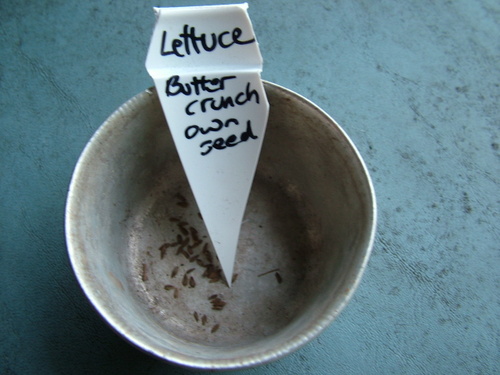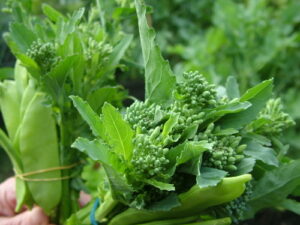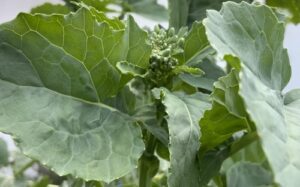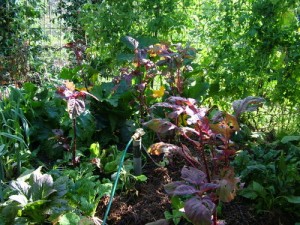This is the lettuces for April and May, planted on the leafy planting days last weekend. These are my own seed so they are free and bountiful. But still there’s no point in planting more than a pinch of them. We take lunches and lettuce is in it practically every day when it is in season, and we would have a salad for dinner a few times a week too. But even so, half a dozen loose leaf lettuces planted each month keeps us supplied.
Buttercrunch is a really good hot weather variety, and this is probably the last round of them I shall plant. Next month I’ll plant a Romaine loose leaf lettuce, probably Rouge d’Hiver and/or Brown Romaine. Planting different varieties each time gives me a bit of insurance, since they respond differently to weather and pests. A few weeks of wet might wipe out my buttercrunches, but the romaines will likely survive it.
This trick of taking only the seeds I intend to plant, not the whole packet, out to the garden is a really good way of making a packet of seeds last through multiple successive plantings. I wrote a whole post about it a little while ago. Such a simple trick for so much benefit.
This is that pinch of seeds today. It was planted in a coolite box full of home made seed raising mix – half creek sand (fine gravel) and half mowed old dry cow pats. I’ll prick these out to transplant and re-use the seed-raising mix for the next batch. It will keep going for years with occasional top-ups. I like using a deep coolite box like this because I find shallow trays or punnets are too vulnerable. I only need to neglect to water once, or get a really hot dry day when I’m not home and I lose them. The deep boxes give me much more leeway.
There’s about 18 baby lettuces have come up. These ones are ready to transplant, and today l shall pot on about a dozen of them, selecting the strongest. Transplanting them at this two leaf stage is quick and easy and causes almost no transplant shock. Culling the weaker seedlings is a good pest and disease control measure. It’s hard to do though – gardeners tend to have a weakness for baby plants! But if I plant all of them, I’ll just use up all the garden space and have no room for the next round.
This is the baby lettuces I shall plant out into the garden today. They were planted as seed a month ago now, at the leafy planting days at the beginning of January, so they are already a month old. They were transplanted at the two leaf stage into their own pot filled with a rich mix of compost, worm castings, with a bit of creek sand for drainage. They have been kept in the shadehouse where I remember to water them. I’ll plant them out by digging a little hole and putting the whole potting mix and all in it, so they are never bare rooted and suffer no transplant shock at all. Often I make little leaf pots and I can plant pot and all. We will be eating them in March and April.
These lettuces were planted as seed back in December and out into the garden a month ago, and we’ve already been sneaking a few leaves from them. About a third of the lettuces in pots never make it out into the garden. I select the strongest 6 or 8 and recycle the potting mix for the rest. At any one time, there will normally be at least 3 beds with lettuce pickable in them, some getting to the end, some in the middle, some just starting to bear, 18 to 24 lettuces in all, plenty for us. Small amounts of sequential planting like this is also less daunting. Even if I am really really busy, I can normally find time to stick half a dozen lettuces in the ground. Planting too many at once is not only a waste, it’s also a pretty effective deterrent to planting any at all!
This is the lettuces we’re eating mostly now. They were planted as seed back in November, planted out into the garden in December, and I was able to start picking them from mid-January. I pick a handful of leaves when we want them. I much prefer loose leaf lettuces because I can do this. These are a cos variety and they managed to cope with the heat waves of December and January, which was a bit impressive of them.
And this was the December/January lettuces. I was impressed by the ability of this variety to survive the heat waves, and its resistance to bolting. They were planted as seed in October, which would be the worst month of the whole year for lettuces in my part of the world. My springs are often hot and dry, and the days are lengthening which spurs them to bolt to seed. But these guys hung in through all that, and you can see from the length of bare stem at the bottom how much lettuce we ate from them. I’ve left two of the slowest to bolt to bear seed. I’ll collect the seed, dry it in a bowl on my verandah table, and that will be the seed I plant next spring.
I plant a pinch of seeds, pot on a dozen baby seedlings, and plant out 6 or 8 advanced seedlings each month, aiming to do it on the leafy planting days mainly because that’s a good reminder and procrastination buster. The September to November plantings are a bit of a long shot and I don’t have high hopes for them, which means there is often a period from December to February when lettuces are in short supply. But for the rest of the year this strategy normally means there are several varieties of lettuce for picking any day I like.









I have only been gardening a couple of years, and am finding that often my “weeks until harvest” are different than what the packet says to expect (maybe because I don’t water much?). But one thing I am loving about succession planting is how it evens this out for me – it doesn’t really matter whether my first round of lettuce takes “50 days full size” or more like 70 if I plant them every month, because we’re almost always still eating the last ones when the next ones start.
It’s also taken the pressure off “quantities to plant”. With lettuce at a few different stages, if I didn’t plant quite enough I can “steal” a bit from the just-starting-to-bear ones, plant out a few extras that are at the seedling stage that month, and slightly increase the number of seeds I plant from then on. Then it’s only a month or two depending on the vegetable before the gap is bridged.
I am using the bottomless milk bottle trick from your book and just plant the seeds straight into those, skipping the coolite box stage, as I have tiny children and saving those ten minutes of pricking out sometimes really is the difference between growing food or not! Some inevitably fail to germinate, and I just poke a couple of new seeds into those pots the following month.
I’m really pleased with how the systems in your book all support and cross-benefit one another – planting like this saves time and water, but also gives me more space in the garden and it’s easy to remember to plant new seeds at the same time that I’m transplanting the seedlings (even when you plant not on moon days, but on nap days!).
Hi Linda, which where do you get your moon calendar from, and are any better than others?
Hi Lydia, on the back of my bedroom wall is a block of calendars about 20 deep! I get one of Thomas Zimmer’s planting calendar each year and somehow I’ve fallen into the tradition of stapling it over top of the year before’s. It will be an archaeological dig eventually. My family and friends know me well enough that one usually comes my way as a gift, but you can buy them online in lots of places.
Hi Amanda, that’s a better explanation than mine of the benefits of planting small amounts sequentially!
You’re so organised! We’re just eating whatever is growing by itself at the moment, and the only lettuces in our garden are cos – we never get sick of them, and they’re so good at self-seeding! 🙂
Thanks for this post — I know I’ve often read ‘plant successively for continual harvest’ on the sides of packets, and it’s really useful to see how to go about actually doing it!
Love your little seedlings! Grow little plants, grow!